Poison dart frogs are fascinating animals who are very well-suited for natural vivaria.
They’re not only small, which is helpful for keepers with space limitations, they’re also some of the most beautiful creatures in the world, who truly embody the notion of “living art.”

But before you set up an elaborate dart frog enclosure, you’ll need to select the species you intend to care for.
This way, you can set up the enclosure in a way that’ll best suit your pets’ needs and give you the best chance for success.
It’s also important that you select species with compatible environmental requirements if you intend on maintaining a mixed-species habitat.
We’ll try to help you do that below, by providing some basic information on some of the most popular dart frog species available on the market.
Quick Navigation
Poison Dart Frog Taxonomy
Scientists currently recognize approximately 200 species of poison dart frog.
It’s difficult to identify the exact number of described species, as authorities often differ on some of the minor points of poison dart frog taxonomy.
Nevertheless, these species are all part of a single group, called the family Dendrobatidae. But these 200-odd species aren’t all equally closely related.
Poison dart frogs are all thought to be descendants of a single, ancestral species, but some of the extant species are more closely related to each other than some others are.
Accordingly, scientists place the various species in one of 16 different groups called genera (singular: genus).
The currently recognized poison dart frog genera are as follows:
- Adelphobates
- Andinobates
- Ameerega
- Colostethus
- Dendrobates
- Ectopoglossus
- Epipedobates
- Excidobates
- Leuocostethus
- Hyloxalus
- Minyobates
- Oophaga
- Paruwrobates
- Phyllobates
- Ranitomeya
- Silverstoneia
However, frogs from most of these genera are not available in the pet trade – at least, not in significant numbers.
Instead, the vast majority of poison dart frogs in captivity are members of a handful of genera, including Dendrobates, Phyllobates, Ranitomeya and Epipedobates.
Notable Poison Dart Frog Species
One of the most appealing aspects of poison dart frogs for amphibian enthusiasts is the diverse array of species that are available.
Below, we’ll provide you with some of the basic information about seven of the most commonly seen species.
Try to pick the ones that are best suited for your situation and that you find appealing.
1. Green and Black Poison Dart Frog (Dendrobates auratus)
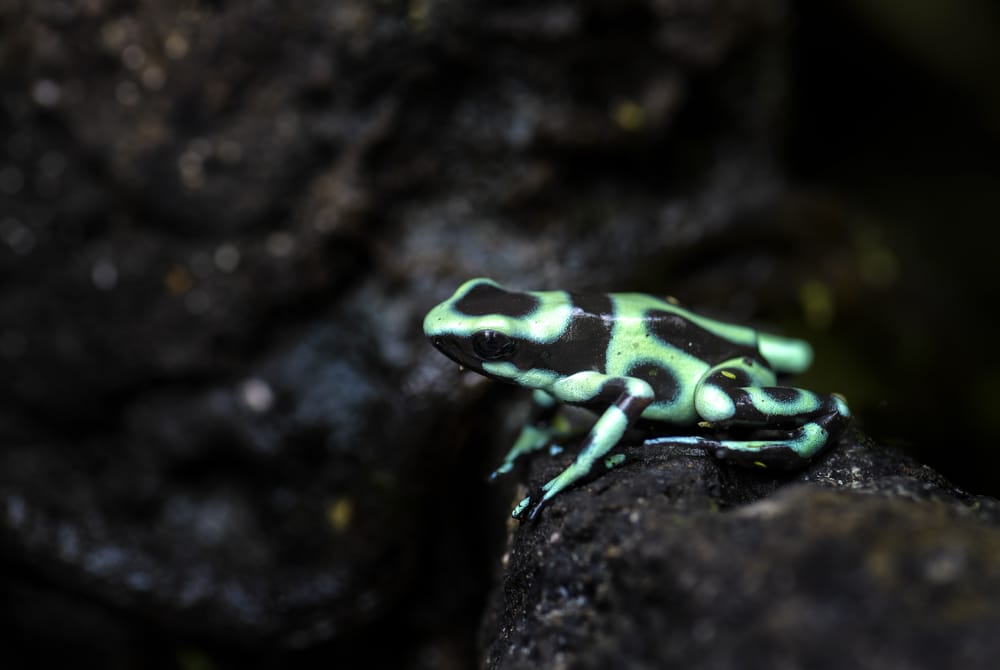
The green and black poison dart frog is likely the most commonly kept species in captivity. And although many advanced keepers eventually move on to other species, this species is typically considered the best one for beginners to choose.
This species has a relatively expansive range relative to many other poison dart frogs, which encompasses a region stretching from Nicaragua and Costa Rica to northern Columbia. They were also introduced to Hawaii in the 1930s to help reduce local mosquito populations.
The green and black dart frogs available in the pet trade are often wild-caught individuals, so care is required when moving or transporting them. They aren’t as toxic as some other dart frogs, but they are dangerous enough to cause human deaths.
Unlike many other poison dart frogs, this species is semi-arboreal and will often climb above the enclosure floor. These frogs occur in several different color patterns. Most are green and black (although the pattern differs), but some individuals possess blue rather than green blotches between the black markings.
2. Bumblebee Poison Dart Frog (Dendrobates leucomelas)
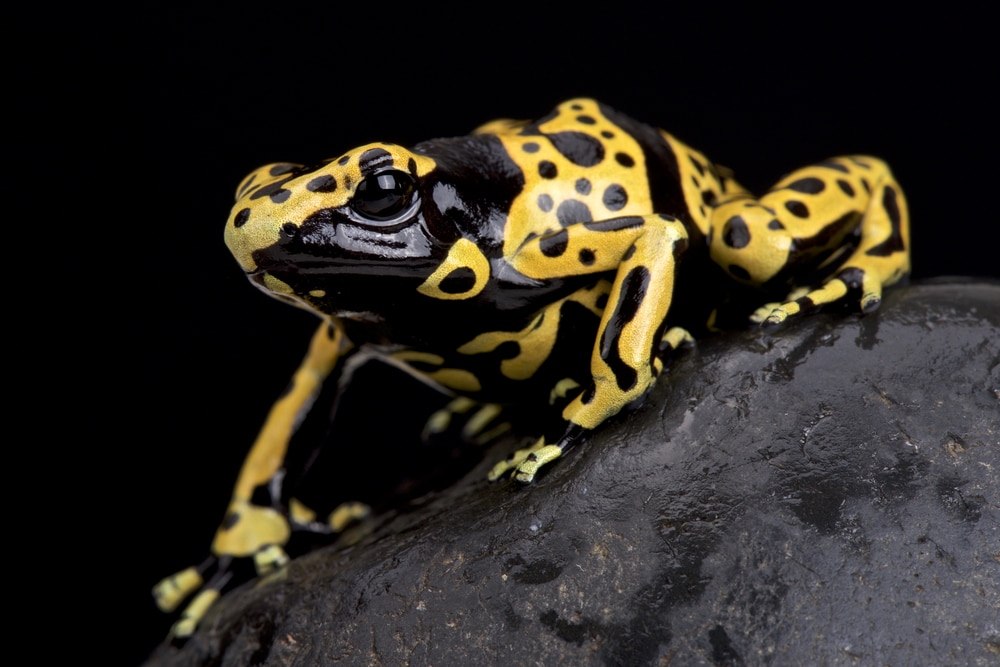
Also called the yellow or yellow-headed dart frog, the bumblebee dart frog is a visually striking species, who is a popular subject with wildlife photographers and frog-keepers alike. These frogs bear a series of yellow and black bands, and the yellow bands typically have small black spots and blotches of black mixed in.
Bumblebee dart frogs are more territorial than some other species, so care is required when keeping large numbers together – especially if they are from different species. They emit very loud vocalizations relative to many other dart frog species, but their calls are still not as loud as those of some other popular frog species.
These frogs are native to Venezuela, and they may even range into neighboring countries. They’re pretty common in the wild, and they breed relatively readily in captivity, so these frogs are often pretty easy for hobbyists to find. These frogs occasionally venture into drier habitats than some other poison dart frogs, and, while they still need very high humidity levels in their enclosures, they’ll tolerate slightly drier conditions than most other species.
3. Dyeing Poison Dart Frog (Dendrobates tinctorius)
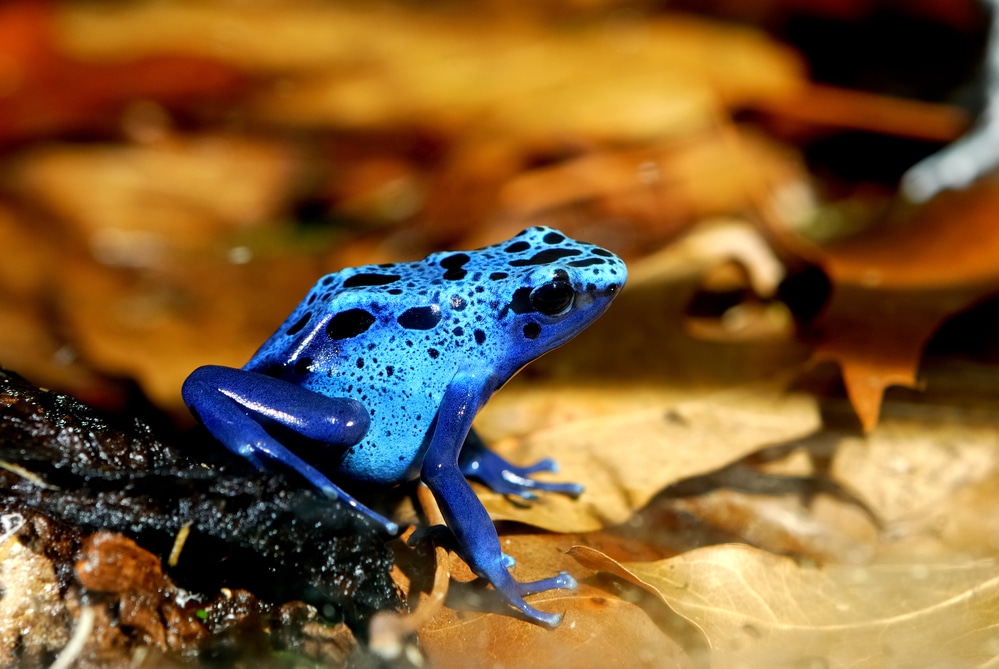
The dyeing poison dart frog is a close relative of the bumblebee dart frog and lives in the same basic region: Venezuela and the surrounding countries of the Guiana Shield. In fact, some members of this highly variable species are also black and yellow in color. Others are clad in various combinations of blue, black and yellow. Interestingly, some color forms appear to be more toxic than others.
Like some other poison dart frog species, the dyeing poison dart frog breeds on land, rather than water. Once the eggs are deposited and fertilized, the male will then carry the eggs on his back to the water, where they’ll hatch and continue to develop.
The dyeing poison dart frog is a fairly large species, and some specimens may reach nearly 2 inches in length. This species occasionally climbs vines and tree trunks, and it may be found up to 6 feet off the ground in its natural habitat.
4. Yellow-Striped Poison Dart Frog (Dendrobates truncates)
The yellow-striped poison dart frog is native to Columbia, where it lives in a variety of habitats, ranging from dry forests to rainforests and swamps. In fact, while they prefer the same type of high humidity levels that other dart frogs do, they will tolerate slightly drier conditions for brief periods of time.
This is a relatively shy species, who may hide more often than some others. However, they are similar to green and black poison frogs in many ways and often make a good choice for beginners, as it is a hardy and relatively undemanding captive. Additionally, they will often thrive when kept in small groups – a characteristic that many keepers find appealing.
Most yellow-striped poison dart frogs are about 1 to 1.25 inches in length. However, this species occurs in several different color forms, and some – notably the “yellow” forms – are slightly smaller.
5. Anthony’s Poison Dart Frog (Epipedobates anthonyi)
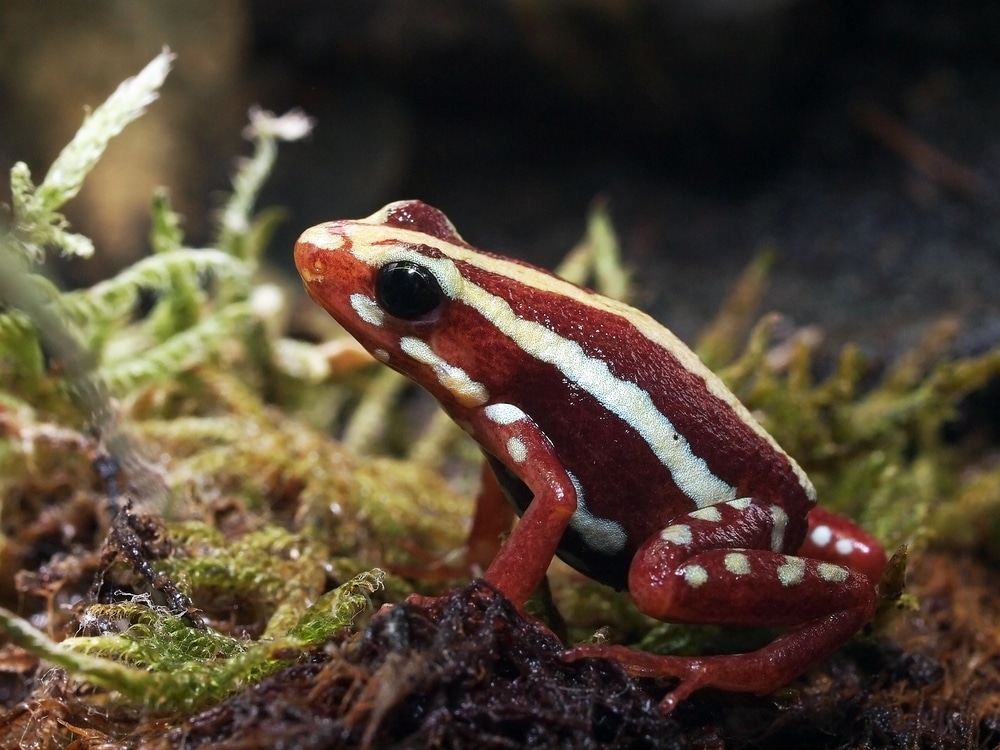
Hailing from Ecuador and portions of Peru, Anthony’s poison dart frog is a close relative of the endangered phantasmal dart frog (Epipedobates tricolor). Although it is listed as “near threatened” by the IUCN Redlist of Threatened Species, this species does show up in captivity and is available for hobbyists.
Anthony’s poison dart frog is typically considered an easy species for experienced frog keepers, and beginners may also have success with these frogs. They should not be kept in mixed-species tanks, and they typically fare best when kept in a tank with only one, opposite-sex companion. They are often relatively easy to breed, but you’ll usually have to establish a running water setup to do so.
Anthony’s poison dart frog is an attractive species, who is typically clad in a red ground color with several longitudinal green to pale white stripes. Green spots and blotches may also appear on the frog’s legs. These frogs usually reach about 1 inch in body length.
6. Golden Poison Dart Frog (Phyllobates terribilis)
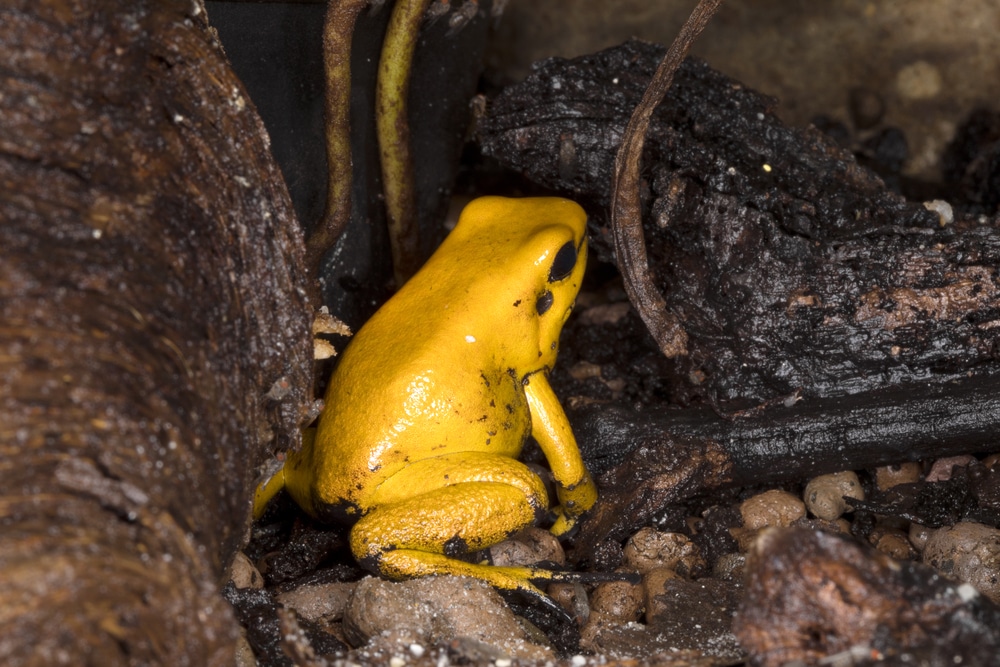
Infamous for being one of – if not the – deadliest poison dart frog species, the golden dart frog is a popular species among many amphibian enthusiasts. Native to Columbia, these frogs actually come in three different color varieties: gold, orange and pale green (often called “mint” by those in the hobby). However, all three species are essentially unicolored, save for dark markings on their feet.
Toxicity concerns aside, golden poison dart frogs are often easy for keepers with some experience to maintain. They don’t present any unusual husbandry requirements, they’re fairly hardy, and they reach relatively large sizes, which is often a trait that makes caring for a given dart frog species easier.
Additionally, while they still require high-humidity habitats, golden poison dart frogs are often able to survive in lower humidity levels than some other dart frogs. They can even tolerate humidity levels as low as 50% for brief periods.
You can keep golden poison dart frogs in small groups – but do not mix them with other species. They are a relatively bold species, who often willing to move about their habitat with relative abandon. This is likely due to their highly dangerous skin toxins, which offer the frogs considerable protection from predators.
7. Bicolor Poison Dart Frog (Phyllobates bicolor)
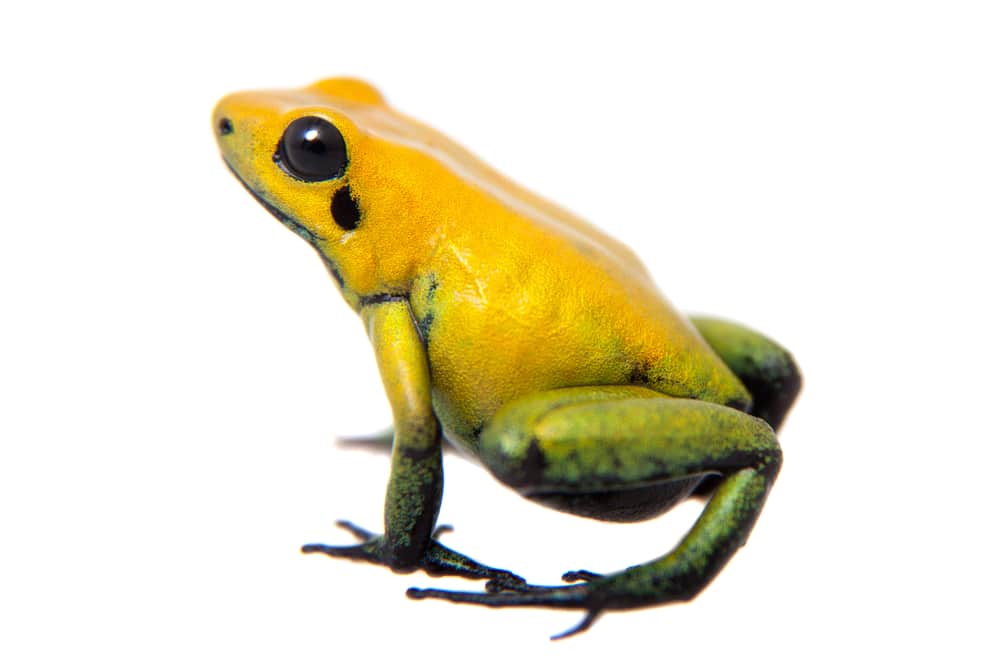
A close relative of the golden poison dart frog, the bicolor dart frog is very similar to its cousin. Like the golden poison dart frog, this species inhabits rainforests inside Columbia and is largely clad in golden colors. However, unlike the golden dart frog, the bicolor dart frog has varying amounts of black or dark-colored dots and markings on the legs and posterior portion of its body.
Aside from its differences in color pattern, the bicolor dart frog can be maintained in the same basic manner as golden poison dart frogs. This species can be kept with other members of its own species, but it shouldn’t be housed in multi-species enclosures. It will also handle temporary episodes of low humidity, and it has a relatively bold personality.
Accordingly, this species is great for display tanks, as it is not only beautiful, but it isn’t as likely to spend most of its time hiding, like some other dart frog species will.
8. Reticulated Poison Dart Frog (Ranitomeya ventrimiculata)
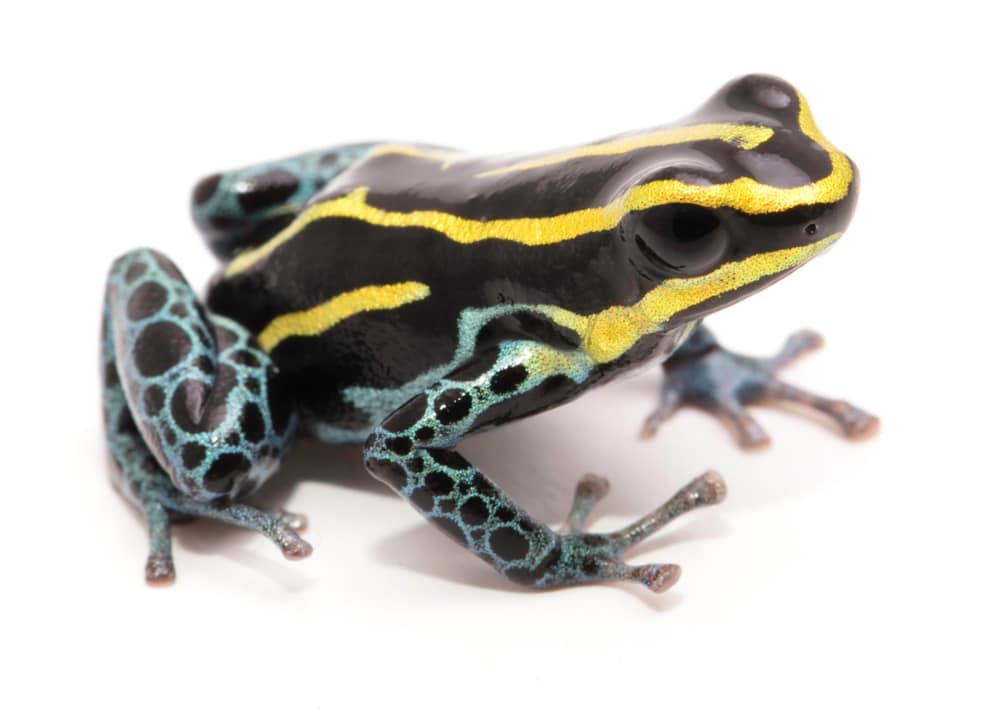
Also called the blue-legged or red-backed poison dart frog, the reticulated dart frog is a small species, which is often included in the “thumbnail” poison dart frog group. Many individuals are less than 1 inch in length, so you’ll definitely need very small food items if you intend to care for this species.
But despite their diminutive size, these frogs are very popular among dart frog enthusiasts – largely due to their very attractive coloration. However, this is not a good species for beginning dart-frog keepers; it is best left to experienced keepers. It is not likely to thrive in the hands of most beginners, and it is typically one of the more expensive dart frogs on the market. Additionally, this species is not bred very easily in captivity, so it isn’t terribly easy to acquire in the first place.
This species is considered moderately toxic when compared to other dart frog species, but care is still required. These are some of the most arboreal frogs in the family, so it is important to provide plenty of climbing opportunities in the habitat.
Most keepers have found that this species thrives best when only housed with one other individual (of the opposite sex). Unless they’re provided with extremely large habitats, they’ll often become aggressive with other members of their own sex.
Always Opt for Captive-Bred Specimens When Possible
No matter which poison dart frog species you decide to keep, it is important to acquire captive-bred specimens whenever possible. Those species that aren’t often bred in captivity (and are therefore only available as wild-caught specimens) should typically be left for experienced keepers.
Not only do wild-caught poison dart frogs present a greater danger to the keeper, but they can also represent a drain on wild populations.
Many frog species – including some poison dart frogs – are disappearing in the wild thanks to habitat destruction, collection for the pet trade, and fungal diseases.
By purchasing wild-caught frogs, you end up contributing to this problem.
Additionally, wild-caught animals of nearly every species are much more difficult to care for.
They often require more veterinary care than their captive-bred counterparts do, and they also take a long time to properly acclimatize to their captive environment.
Accordingly, it is advisable to stick to captive-bred individuals whenever possible.
Final Thoughts
Be sure to consider your choice of species carefully when picking out dart frogs.
Consider the type of care they will require, and – if you intend to keep more than one species in the same habitat – be sure that their needs are all compatible.
With proper species selection and care, you’ll likely find that poison dart frogs can make excellent subjects for natural vivaria.